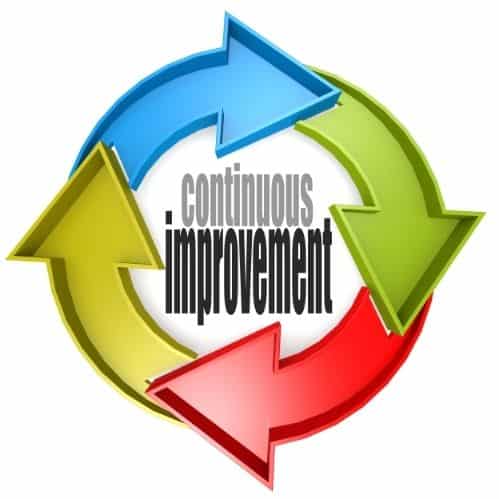Continuous Improvement?

Are You Continuously Improving Your Improvement Initiatives?
Does your continuous improvement need continuous improvement? That’s the topic of this article.
What will you learn?
• What is Good Enough
• How To Improve
• Sponsorship
• Program Analysis
• Root Cause Analysis
• Never Stop Improving

What is Good Enough?
Maybe your program is good enough. You can rest on your laurels. After all, your safety improvement efforts (or quality, Six Sigma, Lean, TPM, patient safety, or other improvement programs) are producing slightly better than industry-average results. Your company meets the minimum regulatory requirements (and maybe exceeds a few). You should leave well enough alone. Everyone has heard the saying…
If it ain’t broke, don’t fix it.
So, sit back, relax, and wait for a crisis to cause you to jump into action.
What? Wait for a crisis? Sure. That’s what complacent people do.
Of course, during a crisis, heads may roll. Plant managers get transferred to “special projects.” Safety, operations, and maintenance managers get fired. And companies get a black eye from the negative press.
You know the names of companies that have waited for a crisis to start improving. They are famous (in a bad way) around the world. Ben Franklin would remind us that those companies are:
Pennywise; Pound foolish.

Think about the risks of waiting for a crisis to improve. You may decide that complacency is not the best improvement strategy.
How To Improve
Four things to consider:
- Plan
- Sponsorship
- What to improve first
- Root cause analysis
First, the plan …. To improve, you need a plan. It should be written, measurable, and sponsored by senior management. The sponsor (senior management) must believe in continuous improvement of the improvement program. The sponsor needs to see the plan as their plan. If the plan is their plan, they will pay attention!
Sponsorship
Why is getting sponsorship difficult? Because management has limited attention—a limited number of “silver bullets.” They must pay attention to the most recent crisis and the current hot topic. Plus, there are always budget troubles and production snafus to worry about. And what about the latest government regulation or mandate?
Their crisis focus keeps them from being proactive and focusing on long-term improvement. They may forget what’s important, proving the saying:
When you’re up to your a## in alligators,
it’s hard to
remember that the objective
was to drain the swamp.

If you’re lucky, you will have management that thinks ahead. They support, or even require, continuous improvement of improvement programs. They want people to gather new ideas, benchmark, and implement improvements.
But what if you are unlucky? You must make improving the improvement program a crisis. That’s what I had to do when I was working at a plant where the plant manager said:
“I don’t need a prioritization system to prioritize improvements,
I need a prioritization system to prioritize my crises!”
I made improving the improvement program a crisis by having the regulator require it and then getting it tied to 50% of the executive’s annual bonus. If the improvement program failed to improve, he lost ½ of his bonus. Now that’s a crisis!
My method was probably too extreme, but what would you do?
Program Analysis
What do you improve first?

That’s a good question. To answer it, you need to network to benchmark your state-of-the-art improvement program against others’ great improvement efforts.
I’ve heard people say, “We do Lean,” “We do Six Sigma,” and “We don’t need to improve.”
Six Sigma programs need to be improved just like any other improvement program. Six Sigma was developed in the mid-’80s, before most people had even heard of the Internet. Many of your engineers were born after that!
What about Lean? It’s older than that!
All managers in charge of improvement programs need to network with industry leaders to learn new tricks and refine their improvement systems. Where can you find leaders across a variety of industries in one place? At the Global TapRooT® Summit.
The Summit is famous for bringing improvement experts, industry leaders, and people who want to benchmark across industries together. When is the next Summit? September 29 – October 3. Where? Knoxville, Tennessee, at the Knoxville Convention Center.

Root Cause Analysis
All improvement programs need a state-of-the-art root cause analysis system. Improvement programs use root cause analysis both reactively to solve problems and proactively (audits/assessments/observations) to prevent problems from becoming incidents.
TapRooT® Root Cause Analysis is the state-of-the-art in root cause analysis. TapRooT® is continuously improved. If you learned TapRooT® years (or decades) ago, you’re behind the times! Catch up!
What should you do to stay up-to-date? First, make sure you have the most recent TapRooT® Books. You can get the whole 10-volume set HERE.
Next, read the book:
TapRooT® Root Cause Analysis Implementation –
Changing the Way the World Solves Problems
What’s next? Take the Stopping Human Error Course before the 2025 Global TapRooT® Summit. I guarantee that you’ll leave with ideas to improve your root cause analysis and improvement programs. The Summit even includes a session to choose your best ideas to implement. Make sure you sign up for it.
Never Stop Improving

Don’t become complacent, and let the next major accident happen at your facility.
Do all you can to keep improvement progress happening. Resist complacency! As Winston Churchill said:
Never, never, never give up!

Make continuous improvement your top priority, and know that success will follow.




